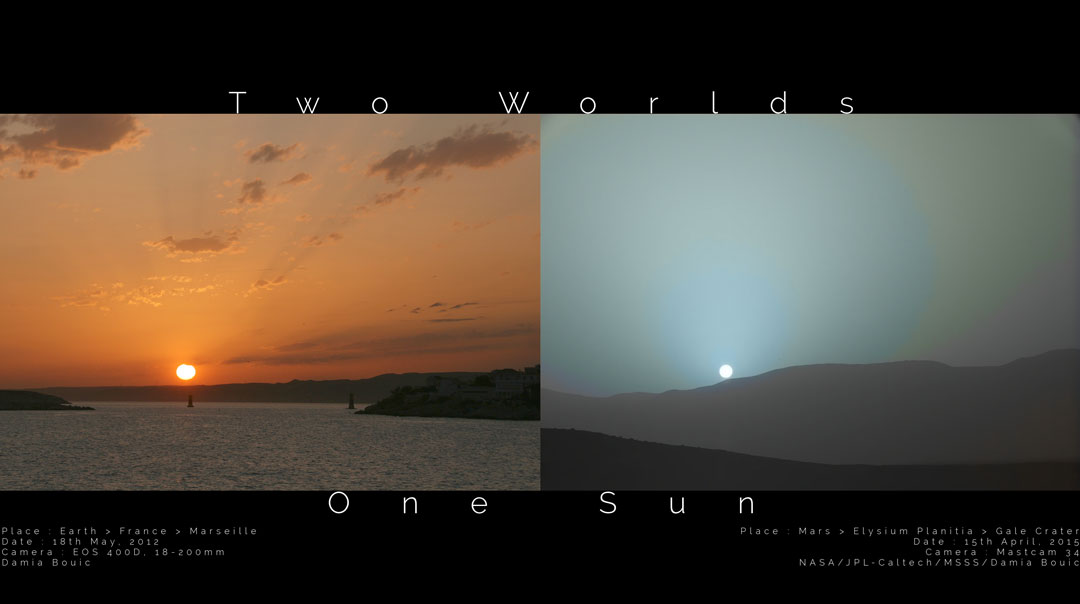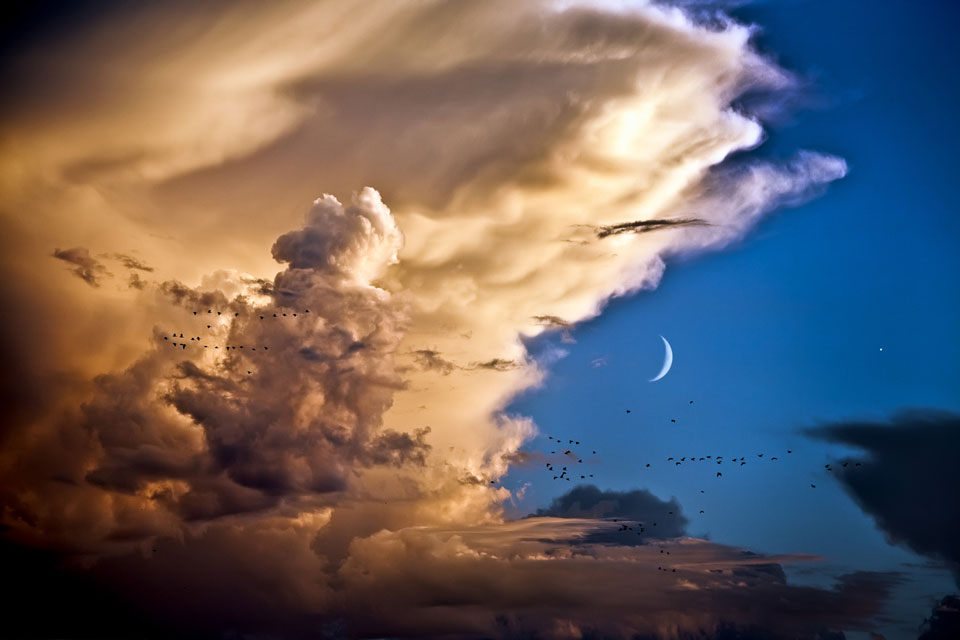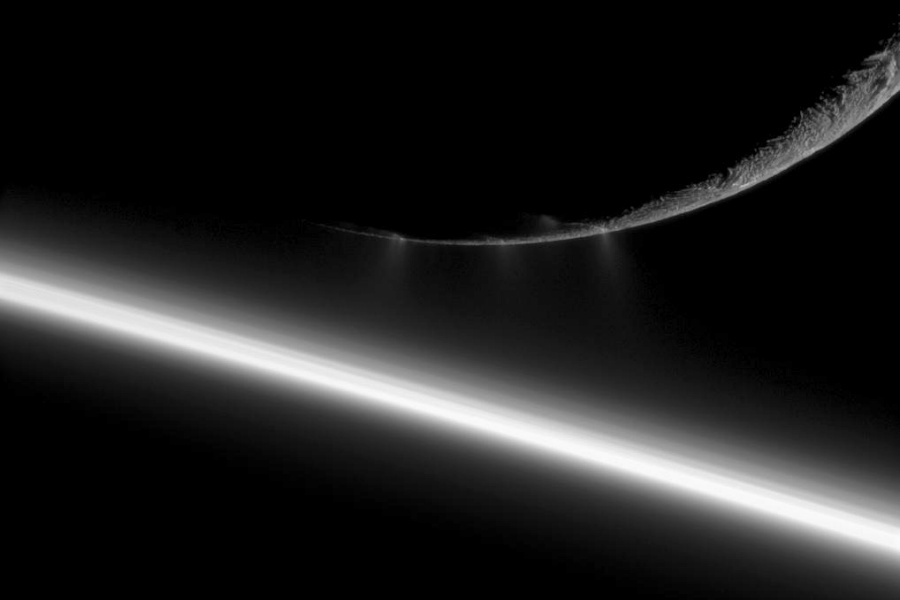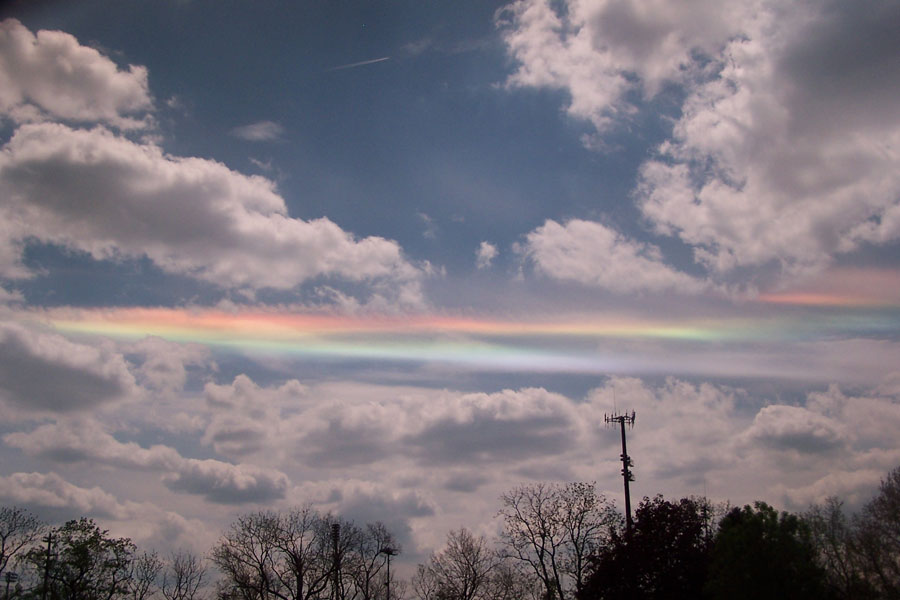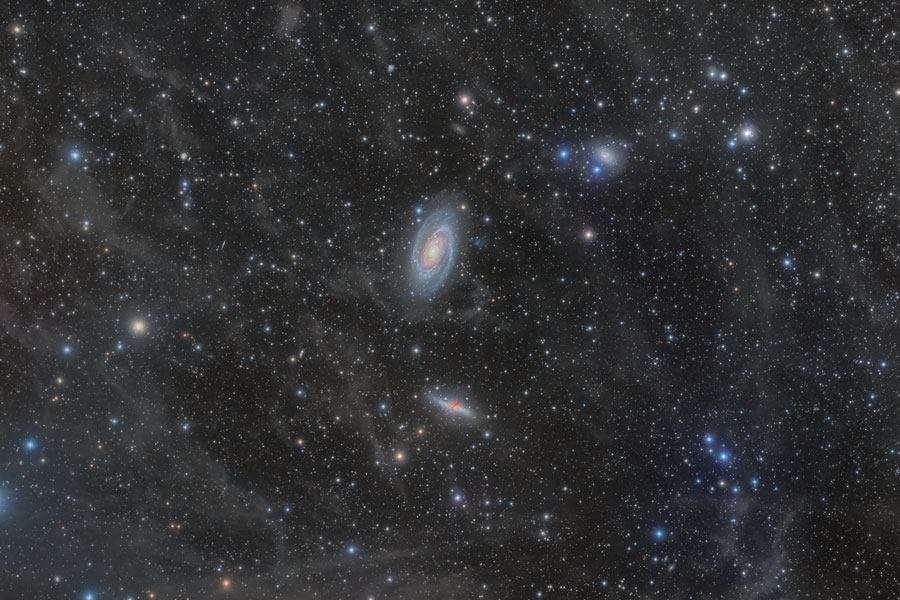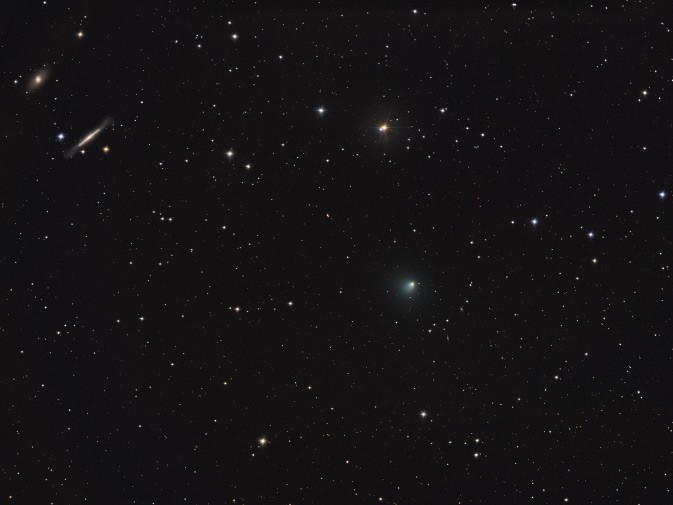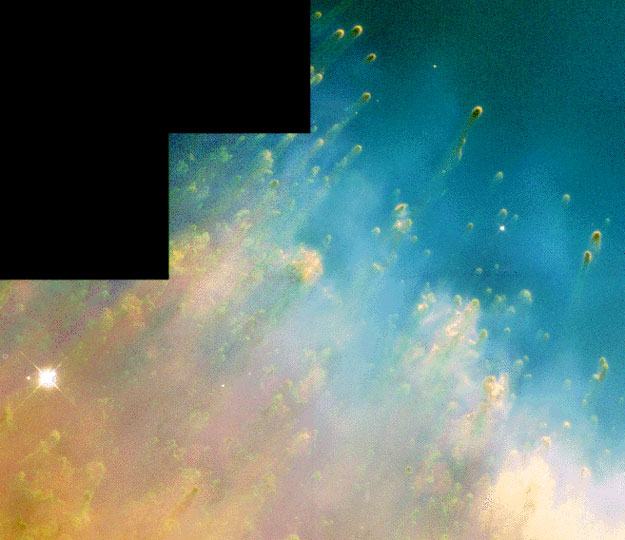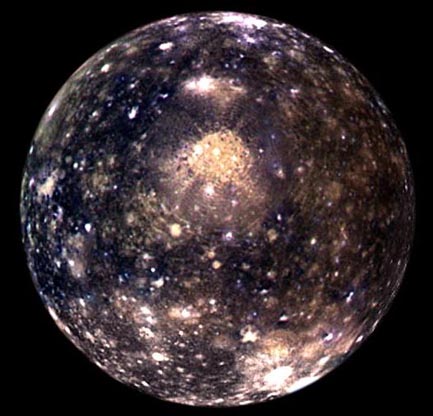| << Previous | Index | Next >> |
2015
2014
Click to play embedded YouTube video.
Video Credit: Illustris Collaboration, NASA, PRACE, XSEDE, MIT, Harvard CfA; Music: The Poisoned Princess (Media Right Productions)
2013 Sometimes the sky above can become quite a show. In early September of 2010, for example, the Moon and Venus converged, creating quite a sight by itself for sky enthusiasts around the globe. From some locations, though, the sky was even more picturesque. In the above image taken in Spain, a crescent Moon and the planet Venus, on the far right, were captured during sunset posing against a deep blue sky. In the foreground, dark storm clouds loom across the image bottom, while a white anvil cloud shape appears above. Black specks dot the frame, caused by a flock of birds taking flight. Very soon after this picture was taken, however, the birds passed by, the storm ended, and Venus and the Moon set. Bright Venus again becomes visible just after sunset this 2013 May and will appear near Jupiter toward the end of the month.
2012 Two stars within our own Milky Way galaxy anchor the foreground of this cosmic snapshot. Beyond them lie the galaxies of the Hydra Cluster. In fact, while the spiky foreground stars are hundreds of light-years distant, the Hydra Cluster galaxies are over 100 million light-years away. Three large galaxies near the cluster center, two yellow ellipticals (NGC 3311, NGC 3309) and one prominent blue spiral (NGC 3312), are the dominant galaxies, each about 150,000 light-years in diameter. An intriguing overlapping galaxy pair cataloged as NGC 3314 is just above and left of NGC 3312. Also known as Abell 1060, the Hydra galaxy cluster is one of three large galaxy clusters within 200 million light-years of the Milky Way. In the nearby universe, galaxies are gravitationally bound into clusters which themselves are loosely bound into superclusters that in turn are seen to align over even larger scales. At a distance of 100 million light-years this picture would be about 1.3 million light-years across.
2011 A sunlit crescent of Saturn's moon Enceladus looms above the night side of Saturn in this dramatic image from the Cassini spacecraft. Captured on August 13, 2010 looking in a sunward direction during a flyby of the icy moon, the view also traces layers in the upper atmosphere of Saturn scattering sunlight along the planet's bright limb. Closer to the spacecraft than Saturn, Enceladus is a mere 60,000 kilometers from Cassini's camera. The south polar region of the 500 kilometer-diameter moon is illuminated, including plumes of water vapor and icy particles spraying above the long fissures in the moon's surface. The fissures have been dubbed tiger stripes. First discovered in Cassini images from 2005, the plumes are strong evidence that liquid water exists near the surface of surprisingly active Enceladus.
2010 Globular clusters once ruled the Milky Way. Back in the old days, back when our Galaxy first formed, perhaps thousands of globular clusters roamed our Galaxy. Today, there are less than 200 left. Many globular clusters were destroyed over the eons by repeated fateful encounters with each other or the Galactic center. Surviving relics are older than any Earth fossil, older than any other structures in our Galaxy, and limit the universe itself in raw age. There are few, if any, young globular clusters in our Milky Way Galaxy because conditions are not ripe for more to form. Pictured above by the Hubble Space Telescope are about 100,000 of M72's stars. M72, which spans about 50 light years and lies about 50,000 light years away, can be seen with a small telescope toward the constellation of the Water Bearer (Aquarius).
2009 Why would clouds appear to be different colors? The reason here is that ice crystals in distant cirrus clouds are acting like little floating prisms. Sometimes known as a fire rainbow for its flame-like appearance, a circumhorizon arc lies parallel to the horizon. For a circumhorizontal arc to be visible, the Sun must be at least 58 degrees high in a sky where cirrus clouds are present. Furthermore, the numerous, flat, hexagonal ice-crystals that compose the cirrus cloud must be aligned horizontally to properly refract sunlight in a collectively similar manner. Therefore, circumhorizontal arcs are quite unusual to see. This circumhorizon display was photographed through a polarized lens above Dublin, Ohio last week.
2008 Large galaxies and faint nebulae highlight this deep image of the M81 Group of galaxies. First and foremost in the wide-angle 12-hour exposure is the grand design spiral galaxy M81, the largest galaxy visible in the image. M81 is gravitationally interacting with M82 just below it, a big galaxy with an unusual halo of filamentary red-glowing gas. Around the image many other galaxies from the M81 Group of galaxies can be seen. Together with other galaxy congregates including our Local Group of galaxies and the Virgo Cluster of galaxies, the M81 Group is part of the expansive Virgo Supercluster of Galaxies. This whole galaxy menagerie is seen through the faint glow of an Integrated Flux Nebula, a little studied complex of diffuse gas and dust clouds in our Milky Way Galaxy.
2007 HD 189733b is a Jupiter-sized planet known to orbit a star some 63 light-years away. But while the distant world is approximately the size of Jupiter, its close-in orbit makes it much hotter than our solar system's ruling gas giant. Like other detected hot Jupiters, its rotation is tidally locked -- one side always faces its parent star as it orbits once every 2.2 days. Using infrared data from the Spitzer Space Telescope, this planet's temperature variations have been mapped out -- the first map ever made for a planet beyond our solar system. Seen here (brighter colors = higher temperatures), the hottest spot on the planet is not at longitude 0.0, the point exactly facing the parent star. Instead, it's about 30 degrees to the east (right), evidence that fierce, planet circling winds influence the temperature. In the planet-wide map, the temperature measurements vary from about 930 to 650 degrees C (1,700 to 1,200 F).
2006 Moving rapidly through planet Earth's night sky, Fragment C of crumbling comet 73P/Schwassmann-Wachmann 3 passed almost directly in front of M57 - the Ring Nebula, and faint spiral galaxy IC 1296 on May 8. In fact, in this gorgeous view, the bright head of Fragment C is separated by only about 0.1 degrees from M57, with the tail apparently engulfing nebula and galaxy. Recorded from Elizabeth, Illinois, USA, this picture corresponds to the cosmic scene only 30 minutes after yesterday's picture of the approaching alignment. The relative motion of the comet against the background stars and nebulae is easy to see when comparing the two images. This comet's fragments will be near their closest approach in the coming days, about 10 million kilometers away, and none pose any danger to our fair planet.
2005 Faint comet Tempel 1 sports a fuzzy blue-tinted tail, just right of center in this lovely field of stars. Recorded on May 3rd slowly sweeping through the constellation Virgo, periodic comet Tempel 1 orbits the Sun once every 5.5 years. Also caught in the skyview are two galaxies at the upper left - NGC 4762 and NGC 4754 - both members of the large Virgo Cluster of galaxies. Classified as a lenticular galaxy, NGC 4762 presents an edge-on disk as a narrow gash of light while NGC 4754 is a football-shaped elliptical galaxy. Similar in apparent size, the galaxies and comet make for an intriguing visual comparison, but Tempel 1 is only about 3 light-minutes from planet Earth. The two Virgo cluster galaxies are 50 million light-years away. NASA's Deep Impact spacecraft is scheduled to encounter Tempel 1 on July 4th, launching a probe to impact the comet's nucleus.
2004 Comet NEAT (Q4) is showing its tails. As the large snowball officially dubbed Comet C/2001 Q4 (NEAT) falls toward the inner Solar System, it has already passed the Earth and will reach its closest approach to the Sun this coming Saturday. Reports place the comet at third magnitude, making it easily visible to the unaided eye to northern sky gazers observing from a dark location just after sunset. The above image was captured last Saturday from Happy Jack, Arizona, USA. Visible is a long blue ion tail, a blue coma surrounding the comet's nucleus, and a shorter but brighter sunlight reflecting dust tail. Q4 will likely drop from easy visibility during the next month as it recedes from both the Earth and the Sun. Another separate naked-eye comet, Comet Linear (T7), is also as bright as third magnitude and should remain bright into June.
2003 Strange shapes and textures can be found in neighborhood of the Cone Nebula. The unusual shapes originate from fine interstellar dust reacting in complex ways with the energetic light and hot gas being expelled by the young stars. The brightest star on the right of the above picture is S Mon, while the region just above it has been nicknamed the Fox Fur Nebula for its color and structure. The blue glow directly surrounding S Mon results from reflection, where neighboring dust reflects light from the bright star. The orange glow that encompasses the whole region results not only from dust reflection but also emission from hydrogen gas ionized by starlight. S Mon is part of a young open cluster of stars named NGC 2264, located about 2500 light years away toward the constellation of Monoceros. The origin of the mysterious geometric Cone Nebula, visible on the far left, remains a mystery.
2002 While exploring the inner edge of the Helix Nebula with the Hubble Space Telescope's Wide Field Planetary Camera 2, astronomers were able to produce this striking image - rich in details of an exotic environment. This planetary nebula, created near the final phase of a sun-like star's life, is composed of tenuous shells of gas ejected by the hot central star. The atoms of gas, stripped of electrons by ultraviolet radiation from the central star, radiate light at characteristic energies allowing specific chemical elements to be identified. In this image, emission from nitrogen is represented as red, hydrogen emission as green, and oxygen as blue. The inner edge of the Helix Nebula, also known as NGC 7293, is in the direction toward the central star, which is toward the upper right. Clearly visible near the inner edge are finger shaped cometary knots.
2001 As a gorgeous full Moon rose above the eastern horizon on February 7, the Space Shuttle Atlantis streaked skyward towards an orbital rendezvous with the International Space Station. Watching from Orlando, Florida, about 60 miles west of the Kennedy Space Center launch site, photographer Tony DeVito captured this digital image, one of a series of pictures of the shuttle's fiery climb. While foreground street lights flickered on and a clear evening sky grew dark, the shuttle's path just grazed the bright lunar disk. On this mission, STS-98, Atlantis carried the U.S. Destiny laboratory module to be added to the expanding orbital outpost. Atlantis is currently scheduled to return to the space station next month.
2000 This false-color image from the Chandra X-ray Observatory reveals a one light-year diameter ring of hot, ten million degree plasma. It is one of the most detailed X-ray images of the expanding blast wave from supernova 1987A (SN1987A). At visible wavelengths SN1987A is famous for its evolving rings, and superposed on this image are white contour lines which outline the innermost optical ring as seen by the Hubble Space Telescope. The composite picture clearly shows that the X-ray emitting shocked material lies just inside the optical ring. In fact, the X-ray emission seems to peak (whitest color) close to where the optical emission peaks (closely spaced contours), a persuasive demonstration that the optical light is produced as the blast wave plows into surrounding material. What will SN1987A look like in the future? According to a popular model, in coming years the expanding supernova blast wave should hit and light up even more material while the violent impacts send reverse shocks back towards the site of the explosion and light up the ejected stellar debris. In any event, astronomers will watch eagerly from a ringside seat as a new supernova remnant emerges.
1999 How did spiral galaxy ESO510-13 get bent out-of-shape? The disks of many spirals are thin and flat, but not solid. Spiral disks are loose conglomerations of billions of stars and diffuse gas all gravitationally orbiting a galaxy center. A flat disk is thought to be created by sticky collisions of large gas clouds early in the galaxy's formation. Warped disks are not uncommon, though, and even our own Milky Way Galaxy is thought to have a small warp. The causes of spiral warps are still being investigated, but some warps are thought to result from interactions or even collisions between galaxies. ESO510-13, pictured above, is about 150 million light years away and about 100,000 light years across.
1998 Callisto is half rock and half ice. This moon of Jupiter is approximately the size of the planet Mercury, making it the third largest moon in the Solar System, after Ganymede and Titan. Callisto's icy surface is billions of years old, lacks any sign of volcanic activity, and is densely covered with rifts and craters. These features are particularly apparent in this contrast-enhanced image taken by the Galileo spacecraft, and released last week. Visible near the image center is Valhalla, one of the largest impact craters in the Solar System, measuring about 4,000 kilometers across. The rings and size of Valhalla make its appearance similar to the Caloris Impact Basin on Mercury.
1997 Does lightning occur only on Earth? Spacecraft in our Solar System have detected radio signals consistent with lightning on other planets, including Venus, Jupiter, Saturn, Uranus, and Neptune. In the above photograph, optical flashes from Jupiter were photographed recently by the Galileo orbiter. Each of the circled dots indicates lightning. The numbers label lines of latitude. The size of the largest spot is about 500 kilometers across and might be high clouds illuminated by several bright lightning strokes.
1996 These five pairs of Hubble Space Telescope images track some of Saturn's moons as they orbit the ringed planet. A pair of images was taken every 97 minutes on November 21, 1995 with the Wide Field Planetary Camera-2, the normally bright ring system appearing nearly edge-on. In the top pair, the large bright moon Dione hangs above center while the smaller moons Pandora, Prometheus, and Mimas (top right image) appear near the planet's disk close to the outer ring. By the second and third pair of images, moons Rhea and Epimetheus have joined the dance. During the Saturn ring plane crossings, the reduction in light from the edge-on rings provided an opportunity for astronomer's to explore Saturn's complex moon system and search for elusive undiscovered satellites.
| << Previous | Index | Next >> |
